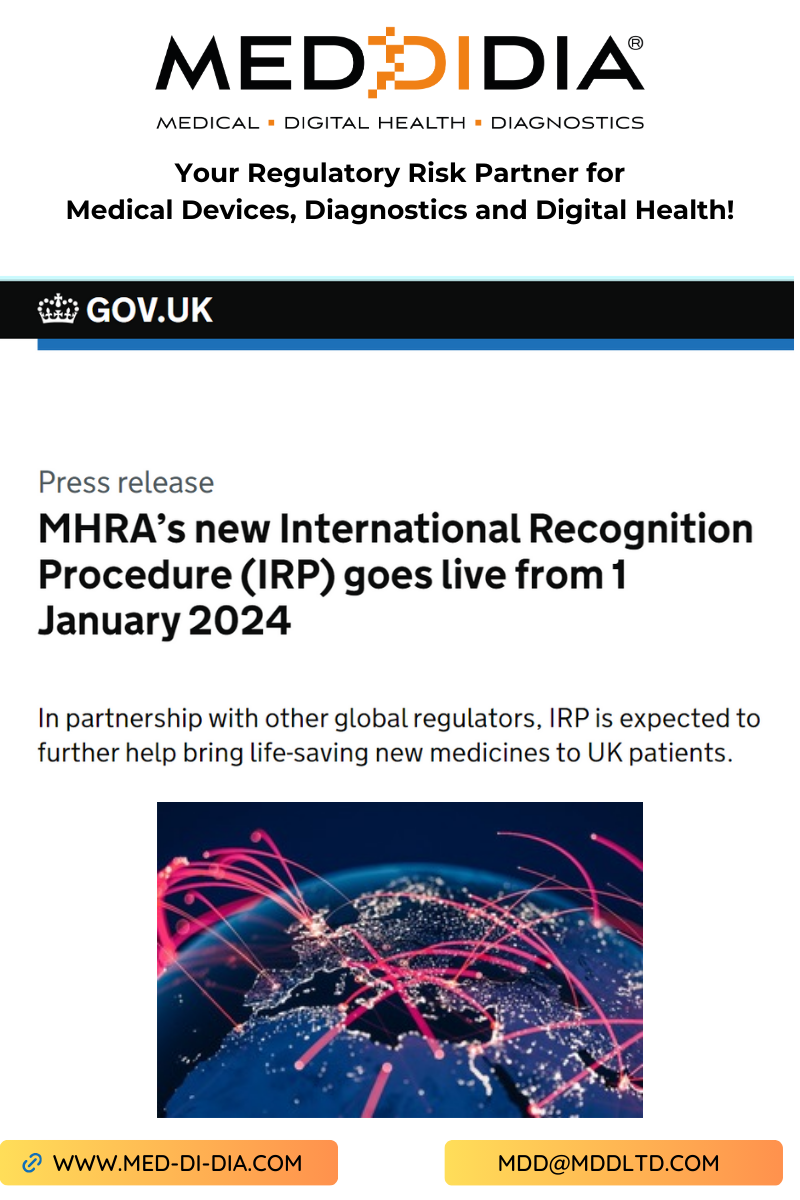ECDRP replaced by IRP in the UK
5/1/2024
From 1st January 2024, the Mutual Recognition and Decentralised Reliance Procedures will come within the scope of the UK’s IRP. This new procedure is unique to the UK and is available to pharmaceutical companies who have received an authorisation from one of the MHRA’s specified Reference Regulators (RRs) for the same medicine they want to place on the UK market. Current Jurisdictions for acceptable RRs are:
- Australia
- Canada
- European Union/European Economic Area
- Japan
- Singapore
- Switzerland
- United States
IRP can be used for new and known active substances, generics, hybrids, biosimilars and new fixed combination products. This new procedure can only be used where an acceptable RR has completed a full and standalone assessment. Any RR assessment based on ‘reliance’ or ‘recognition’ only, is excluded from the IRP.
This is a very positive step post-Brexit providing a foundation for the MHRA to partner with other trusted global regulators and speed up the process of giving UK patients access to new life-saving medicines. It also allows for harmonisation of regulations across the different jurisdictions making licence applications more streamlined and efficient.
Here are the key points that pharmaceutical companies need to keep in mind:
- New Procedure: Starting 1st January 2024, the International Recognition procedure (IRP) will replace the EC Decision Reliance Procedure (ECDRP). Pharmaceutical companies need to familiarise themselves with the IRP to determine if any of their medicinal products qualify to use this regulatory pathway to the UK market and if so, to revisit their regulatory strategy.
- Eligibility: The IRP is open to applicants who have already received an authorisation for the same product from one of MHRA’s specified Reference Regulators (RRs). The same product is defined as having the same active substance(s) and excipients, and the same pharmaceutical form. Also the Applicant must belong to the same company or group of companies (‘licensees’) and must be established in the UK (Great Britain or Northern Ireland) or in the EU/EEA.
- Recognition Routes: There are two recognition routes under the IRP - Recognition A (60-day timetable, no clock stop) and Recognition B (110-day timetable to allow time to consult with the Commission on Human Medicines - CHM). The suitability for each route is determined by submitting an eligibility form and depends on various factors. For example, if the medicine is co-packaged with a medical device component which isn’t EU CE or UKCA marked then Recognition B will be the mandatory application route.
- Submission Requirements: IRP applications can only be submitted through the Human Medicines Portal in the EU format of the electronic Common Technical Document (eCTD) and with a UK-specific module 1 (further guidance will be issued in due course). For an IRP application to be validated, certain information must be included in the cover letter, for example: the recognition route, the RR, the type of RR approval, any conditions or differences, etc.
- National Considerations: The medicinal product must meet MHRA requirements as well as following the EU format. There are also UK-specific considerations which companies need to be aware of.
- Fees: Fees for submission for international recognition applications will be published on the MHRA website in due course.
The UK’s new procedure is a significant ‘step change’ and therefore, needs to be assessed and incorporated into a company’s approach to their regulatory compliance activities. It may even require a major overhaul of the organisation’s regulatory strategy in order to embrace the opportunity for a potential fast-track onto the UK market. With this in mind, it is vital that regulatory departments and decision makers remain up-to-date on changes being brought about by the UK’s MHRA and to take action as appropriate.
What action should UK/EU/EEA Pharmaceutical companies take?
- Understand the New Procedure: Familiarise yourselves with the new International Recognition procedure (IRP) effective from 1st January 2024.
- Check Eligibility: Ensure that your product has already received an authorisation from one of MHRA’s specified Reference Regulators (RRs). The product should have the same composition, pharmaceutical form, and belong to the same company or group of companies.
- Determine Recognition Route: Decide on the recognition route - Recognition A or Recognition B. Note: where there is a medical device or IVD component (co-packaged with the medicinal product) which isn’t EU CE or UKCA market, the Recognition Route B will be mandatory.
- Prepare Submission: Prepare the IRP application to be submitted in the EU eCTD format (with a UK-specific module 1) via the Human Medicines Portal. The cover letter should include specific information as listed in the update.
- Consider National Requirements: Ensure that the product meets MHRA requirements and follows the EU format. Pay attention to UK-specific considerations which may apply to your product.
- Plan for Fees: Keep monitoring the MHRA website for the publication of fee information for submitting an IRP.
At Med-Di-Dia, our experts are providing Medical Technology and Pharmaceutical companies with end-to-end compliance support. Working with our sister company, GRS (www.globalregulatoryservices.com), we are experienced in the regulatory and compliance requirements for drug-device combination products. Our support includes the following:
- Regulatory Strategy Development;
- EU/UK Gap analysis;
- Product Registration and Approval;
- Compliance Audits;
- Documentation Support;
- Post-Implementation Review;
- Liaison with Regulatory Bodies;
- Risk Assessments; and
- much, much more!
Contact us by sending an email to: mdd@mddltd.com or by completing an online webform via our UK-based sister company – Global Regulatory Services (GRS) – via this weblink: https://globalregulatoryservices.com/global-regulatory-services-contact-details








